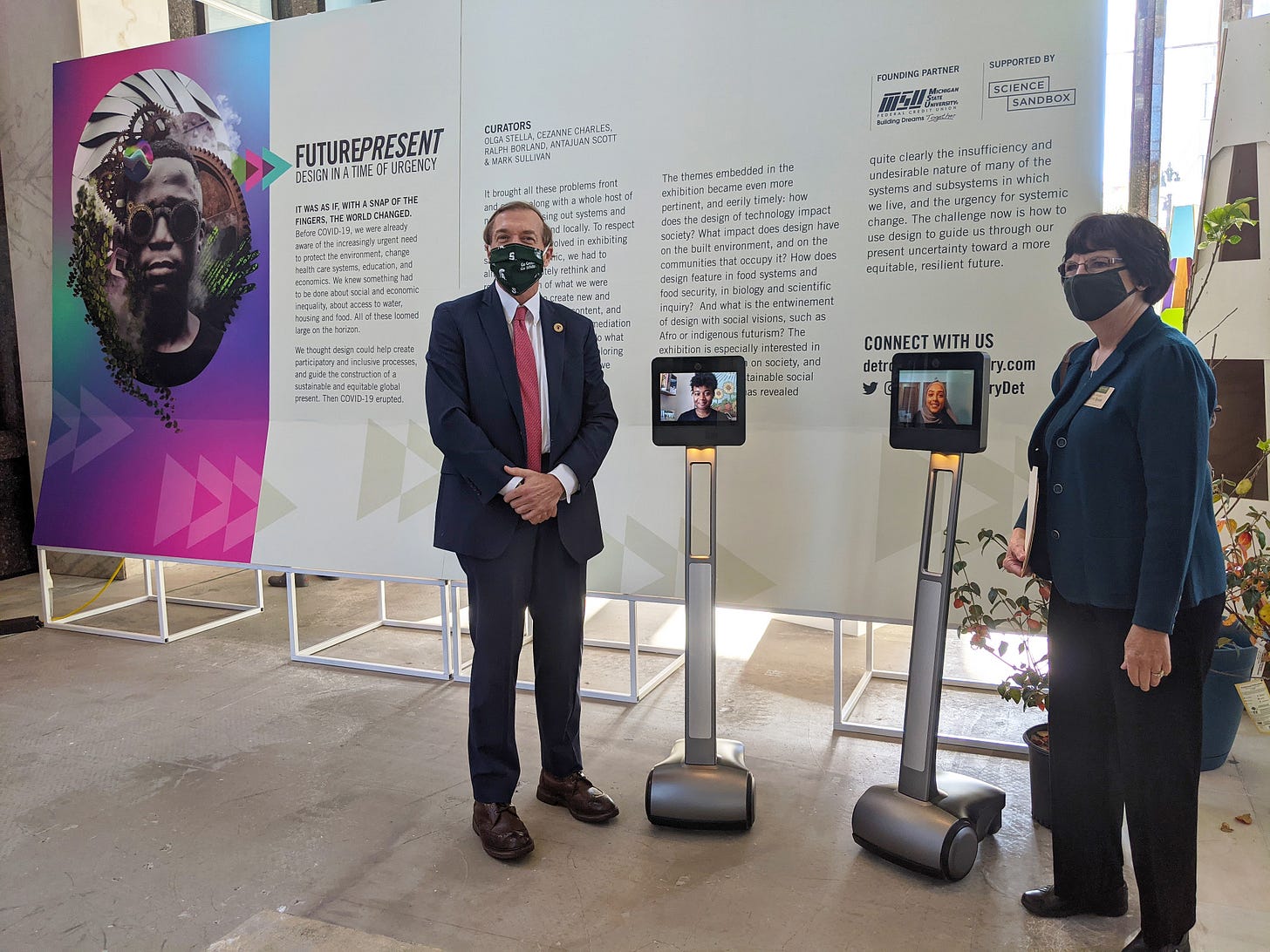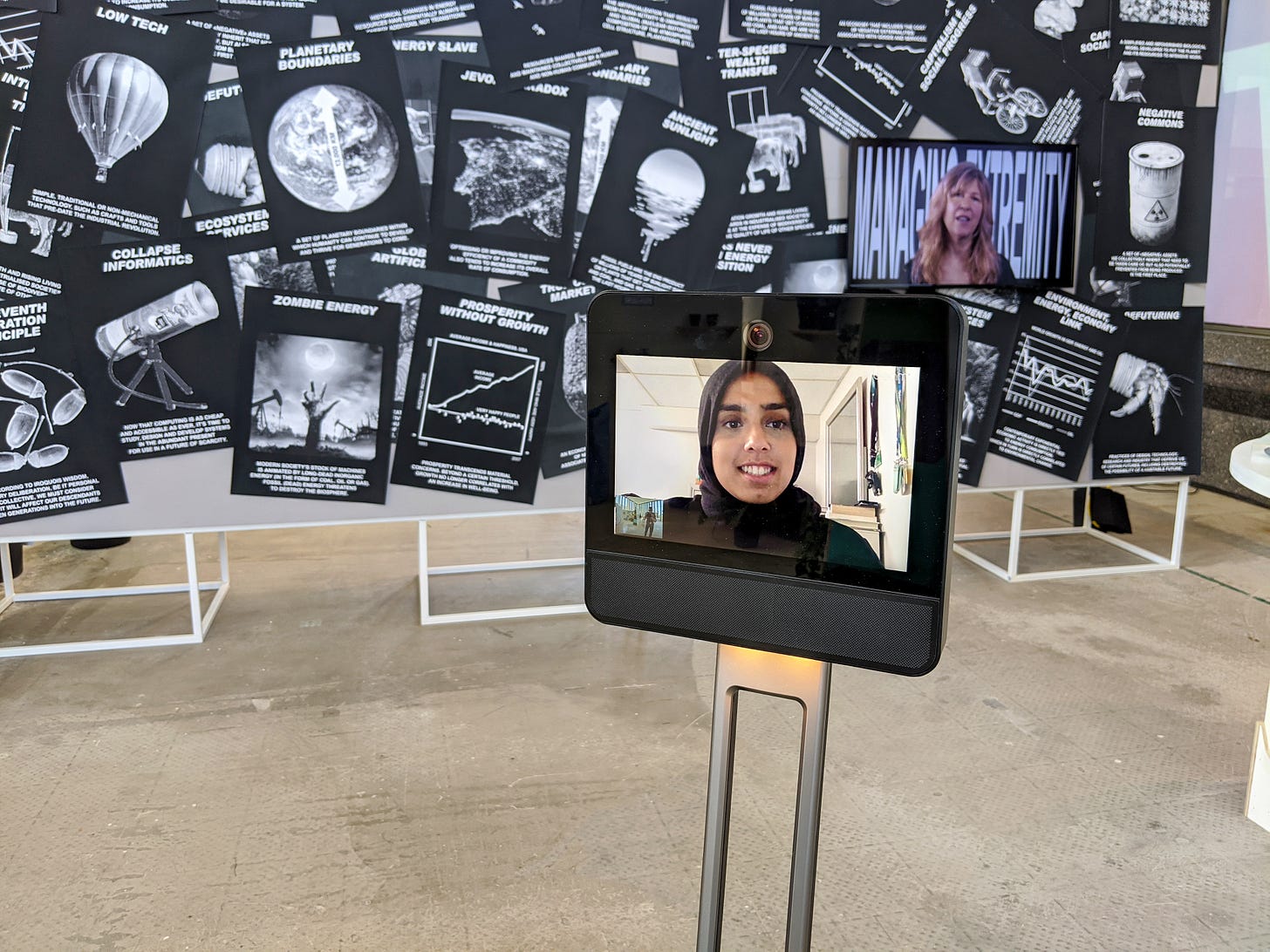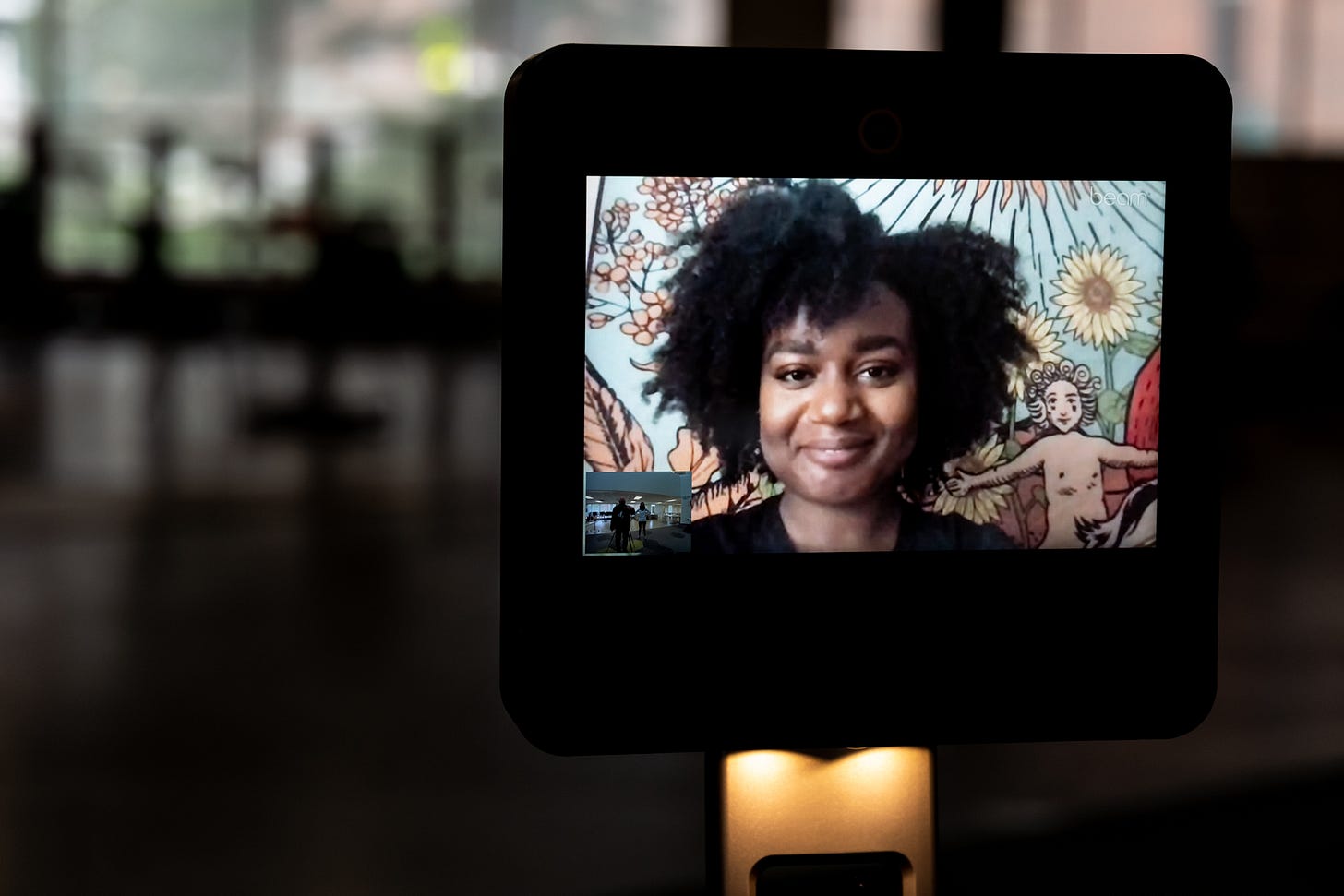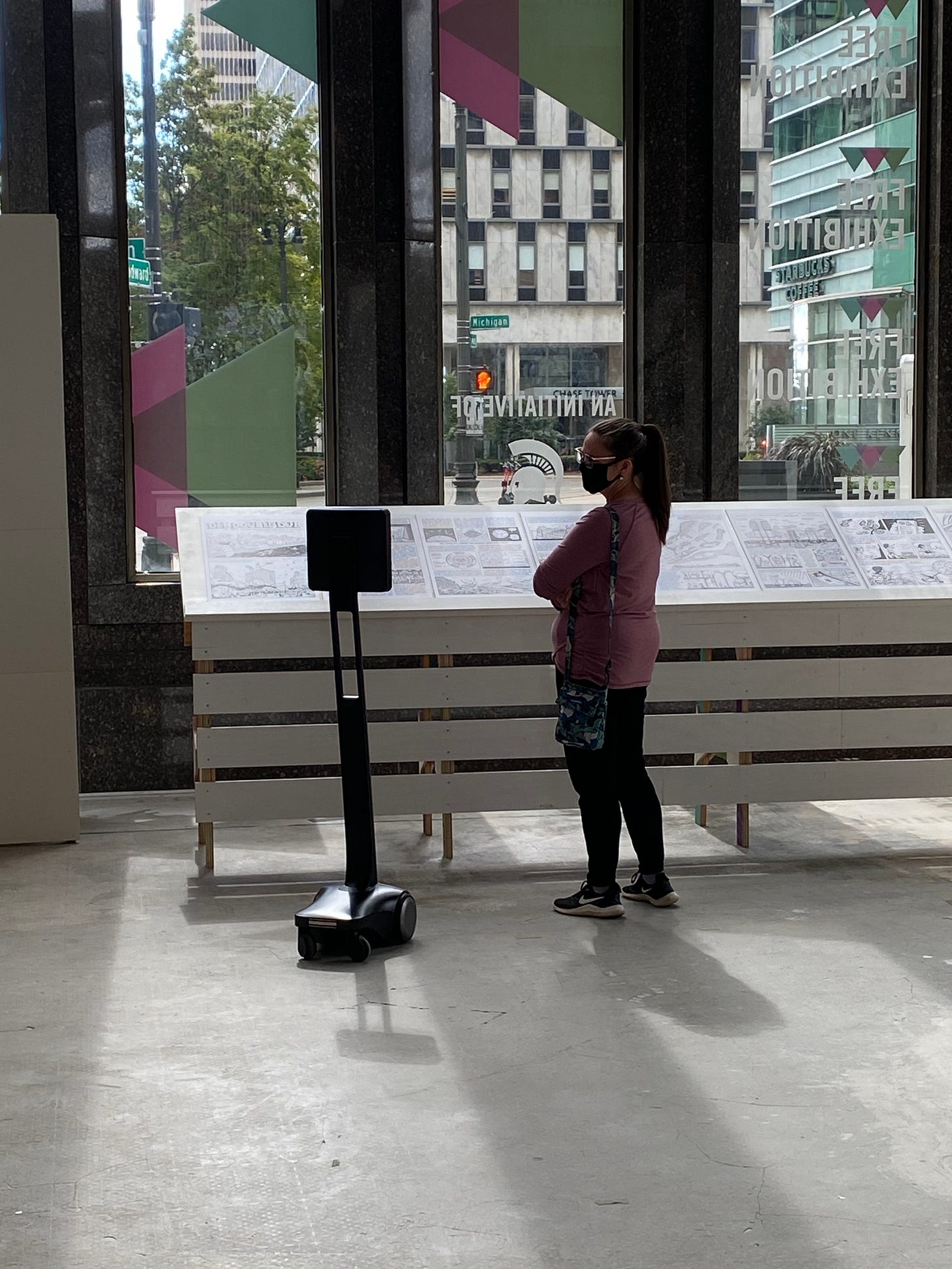The following piece was written by my colleague Caroline White, education and learning manager with MSU Museum’s CoLab Studio.
When COVID-19 forced many organizations to shift online or cease operations in 2020, the MSU Museum CoLab Studio1 was in the middle of preparing for our exhibition, FUTURE PRESENT: Design in a Time or Urgency. The exhibition planned to examine the ways design shapes our lives, from the technologies we use to methods of designing a more equitable, sustainable future. We had envisioned interactive, hands-on experiences and intense conversation and engagement between visitors. Now, confronted with a global pandemic and a world that felt frozen in time, we faced a significant design challenge of our own, particularly as it related to our CoLaborator2 team.

CoLaborators are a team of undergraduate and graduate students that spark thoughtful discussions, facilitate ideas, and infuse learning and creativity through MSU Museum exhibitions and outreach. At its core, the CoLaborator program is an intentionally designed learning experience that focuses on developing transdisciplinary mindsets and science communication, critical thinking, project management, and problem-solving skills.
The conversations CoLaborators have with visitors are essential, not only to the experience of the exhibition, but to their professional and personal development. Engagement with visitors helps students develop communication skills, build confidence, consider new career interests, and utilize more transdisciplinary and multidisciplinary thinking (Enros & Bandelli, 2018). We wanted to ensure they could continue to engage in meaningful conversations with visitors in a manner that was comparable to their in-person engagements.
THE DESIGN QUESTION
How might we maintain the learning that happens through synchronous conversations in the gallery while keeping CoLaborators and visitors as safe as possible?
THE GOALS
- Create a learning experience for the CoLaborators that could compare to the richness of their in-person conversations
- Maintain CoLaborators’ employment during the COVID-19 pandemic
- Keep CoLaborators safe and create the ability to flip to an online-only context if needed
WHAT WE DID
Based on the success of Gleason and Greenhow (2017) in using social robotic telepresence systems (SRTSs) to enhance students’ sense of social presence in blended classrooms, we experimented with using these robots as a way for CoLaborators to engage with gallery visitors remotely. The telepresence robots could be controlled from any location using a downloadable software application, which had an interface like the screen in a first-person video game. CoLaborators could use their keyboards to move the robot freely around the gallery space and view and speak with visitors through a video screen. Alongside this remote facilitation, we tasked the CoLaborator team with designing digital content for a smartphone tour, our social media channels, and the blog. This created additional methods of sharing the exhibition experience and working with the CoLaborators if COVID-19 numbers required us to close the physical exhibition earlier than anticipated or in the event we needed to switch to an entirely online context.

WHAT WE LEARNED
Telepresence robot facilitation created learning and engagement nearly equal to in-person engagements for both visitors and CoLaborators
CoLaborators were shocked by the natural movement and smooth engagement of the telepresence robots, and reported rich dialogue with visitors and meaningful experiences similar to what they experienced when speaking in-person. Visitors would ask questions about books CoLaborators had on their shelves in the background or the artwork on their walls, creating more personal engagement as well.

“Telepresence robot facilitation is the most creative solution in workplace accessibility I have ever witnessed. The robot setup allows me to maneuver around the gallery space freely with a clear 180-degree view. As a “robot” CoLaborator, I continue to have meaningful conversations with gallery visitors without jeopardizing my health or the visitor’s health during the COVID-19 pandemic. In an increasingly technical world, embracing telepresence robots has the potential to transform the workspace and other settings into more inclusive environments for those who cannot join physically due to distance, time, health, or disability constraints.”3 — Shanmin Sultana, CoLaborator
“Even though we are in a virtual setting now, that doesn’t change the value of your perspective.” — Zaria Contejean, CoLaborator
The robot facilitation was frequently named one of the most memorable parts of the experience with FUTURE PRESENT in our visitor feedback survey. Overall, visitors rated their experience speaking with a CoLaborator at a 4.45 out of 5, with 5 being an extremely positive experience. This compares closely to our results for in-person engagements during our subsequent exhibition, TRACKED & TRACED (4.55 out of 5).
“Speaking to a strolling robot took a little getting used to, but the information they provided was great and I didn’t mind at all in the end” — Comment in visitor feedback survey
“She was charming, and it was a delightful experience!!” — Comment in visitor feedback survey
Telepresence work allowed increased workplace adaptation and flexibility
It was far easier in the remote context to navigate schedule challenges and staffing changes. While some of this is likely due to the pandemic reducing (or eliminating) commute times, CoLaborators could quickly step in and support one another when they could not make a shift, while still having enough time to shift to their other commitments such as attending online classes. We had far fewer instances of staffing challenges than we experienced in-person, and we were also able to make our staff meetings more accessible by switching to an online-only context.
Education team participation and leadership in content creation leads to richer digital engagement and a wider definition of communication skills
The CoLaborator team had complete creative agency over the content of our smartphone tour and worked closely with our communications manager on social media content. The ability to tell the story about a given exhibit through infographics, short interviews, videos, sketches, or games, allowed the CoLaborators to reflect critically on the key aspects of a work and capture their knowledge (and visitors attention) through other methods and strategies rather than dialogue alone. The team reported feeling like their definition and understanding of effective science communication had expanded; learning more effectively from each other’s content and creative interpretation; and enhancing their communication skills across mediums.
WHAT WE WOULD CHANGE
More reliable telepresence software
The brand of telepresence robots we had available utilized software that had not been maintained by the company actively over the previous year. This resulted in an increased number of glitches and trouble connecting with the platform, that, while manageable, created disruptions in CoLaborators’ and visitors’ engagements with each other. We would look toward a more reliable platform that is actively maintained for future interactions.
More focus on visitor initial engagement and introduction to the telepresence mediation
CoLaborators and visitors both reported a sense of unease among some visitors around the initial engagements with the robot. Some CoLaborators used the visitors’ discomfort as a conversational talking point given the broader themes of the exhibition, but more often it was difficult for a CoLaborator to virtually determine comfort levels. As with many of our online engagements during COVID, it was challenging for the CoLaborators to gather a sense of visitors’ body language and determine when to approach or when to take a step back and let visitors explore on their own. We began to mitigate this by increasing the amount of verbal communication and check-ins that CoLaborators engaged with (i.e., “would you like me to stay with you?” “do you want some time to look on your own and I can check back in?”) and shifting our gallery presence training to focus on reiterating verbal cues rather than other sensory signals. In the future, we would be more consistent in introducing the virtual CoLaborator concept when visitors walk in the door (and in registration materials), and provide more articulated strategies for CoLaborators to better navigate engagements with visitors from a remote setting.
“It was a cool idea, but I experienced it as a little startling and unsettling.” — Comment in visitor feedback survey
Pairing robot CoLaborators in the gallery
Typically, we have at least two CoLaborators on the floor of the gallery space. In this remote context, we only had a single CoLaborator working on the robot. While this worked generally well for average traffic days, the busier windows with multiple groups attending were difficult for the single CoLaborator to manage, particularly as the robot made it tricker for the CoLaborator to find a break in conversation or use motion to excuse themselves and check on another group of visitors. Additionally, the CoLaborators felt they lost some of the in-gallery knowledge sharing and relationship building with their peers despite virtual Zoom sessions and space for more casual conversation. For both visitor experience and relationship building, we would keep the two person staffing model for CoLaborators working remotely.
FUTURE APPLICATIONS
Telepresence robots could be used to engage both visitors and staff in experiences that may originally be inaccessible to them. As we returned to an in-person format for our CoLaborator team, we kept a telepresence robot in the gallery for CoLaborators that were high-risk, distant from campus, or not yet comfortable returning to in-person engagements. This hybrid approach worked well and helped our team feel secure and safe in their roles. We hope to continue to experiment with the ways that robots could help increase access to different learning spaces throughout the Museum .

REFERENCES
Enros, K. & Bandelli, A. (2018). ‘Beyond self-confidence: a participatory evaluation of personal change in Science Gallery’s Mediators’. JCOM 17 (03), N01. https://doi.org/10.22323/2.17030801
Gleason, B., & Greenhow, C. (2017). Hybrid learning in higher education: The potential of teaching and learning with robot-mediated communication. Online Learning [formerly Journal of Asynchronous Learning Networks (JALN)].
White, C. (2020, November). Robot Mediators, Mediator Apps and Virtual Tours. Invited presentation to the Science Gallery Network.
FOOTNOTES
1 In 2017, Michigan State University partnered with Science Gallery International to launch Science Gallery Detroit, which became the first member of the esteemed Science Gallery Network in the Americas. However, in July 2021, Science Gallery Detroit became a programmatic division of the Michigan State University Museum aimed at experimentation and innovation. This pivot came following many new developments at Michigan State University, including a new strategic plan —MSU 2030— which established new priorities for the University. In light of this, the purpose of MSU’s Science Gallery changed from its initial conceptualization. As of fall 2022, MSU’s Science Gallery became the MSU Museum CoLab Studio. The Studio’s timely and relevant programs are novel, transient, and experimental. This approach enables our team to explore new methods for designing and implementing programming, informal learning, and community engagement. Findings from our work enable the MSU Museum to capitalize on new ways to engage students, faculty, and researchers as it works to maximize its mission. To this end, the CoLab Studio helps to push the boundaries of what it means to be a 21st century interdisciplinary museum.
2 While we were known as MSU’s Science Gallery, our student team was called mediators. In the shift from MSU’s Science Gallery to the CoLab Studio, the student team became known as the CoLaborators.
3 From https://sciencegallery.org/stories/robot-mediators-reinventing-mediation-in-a-time-of-urgency